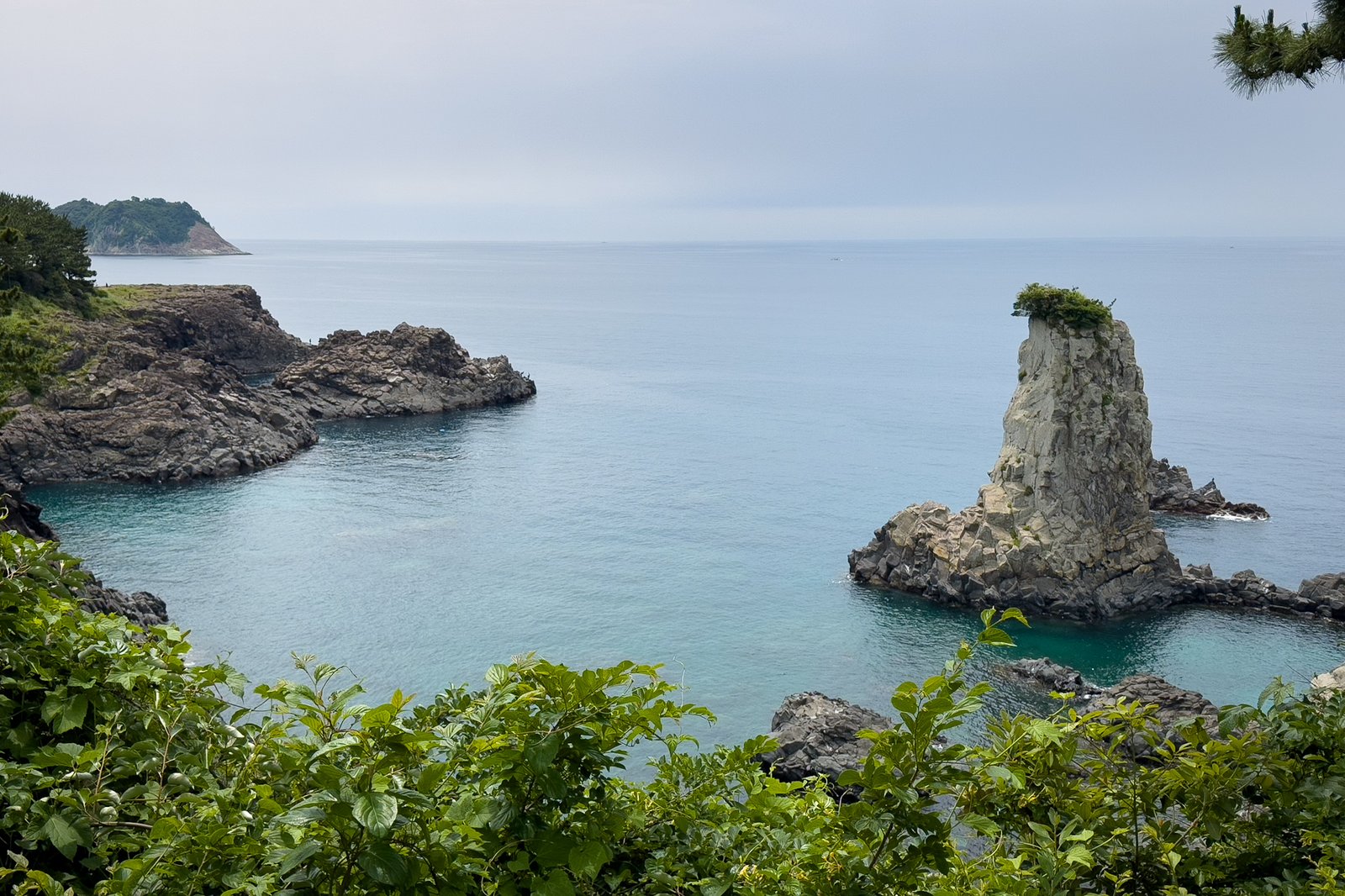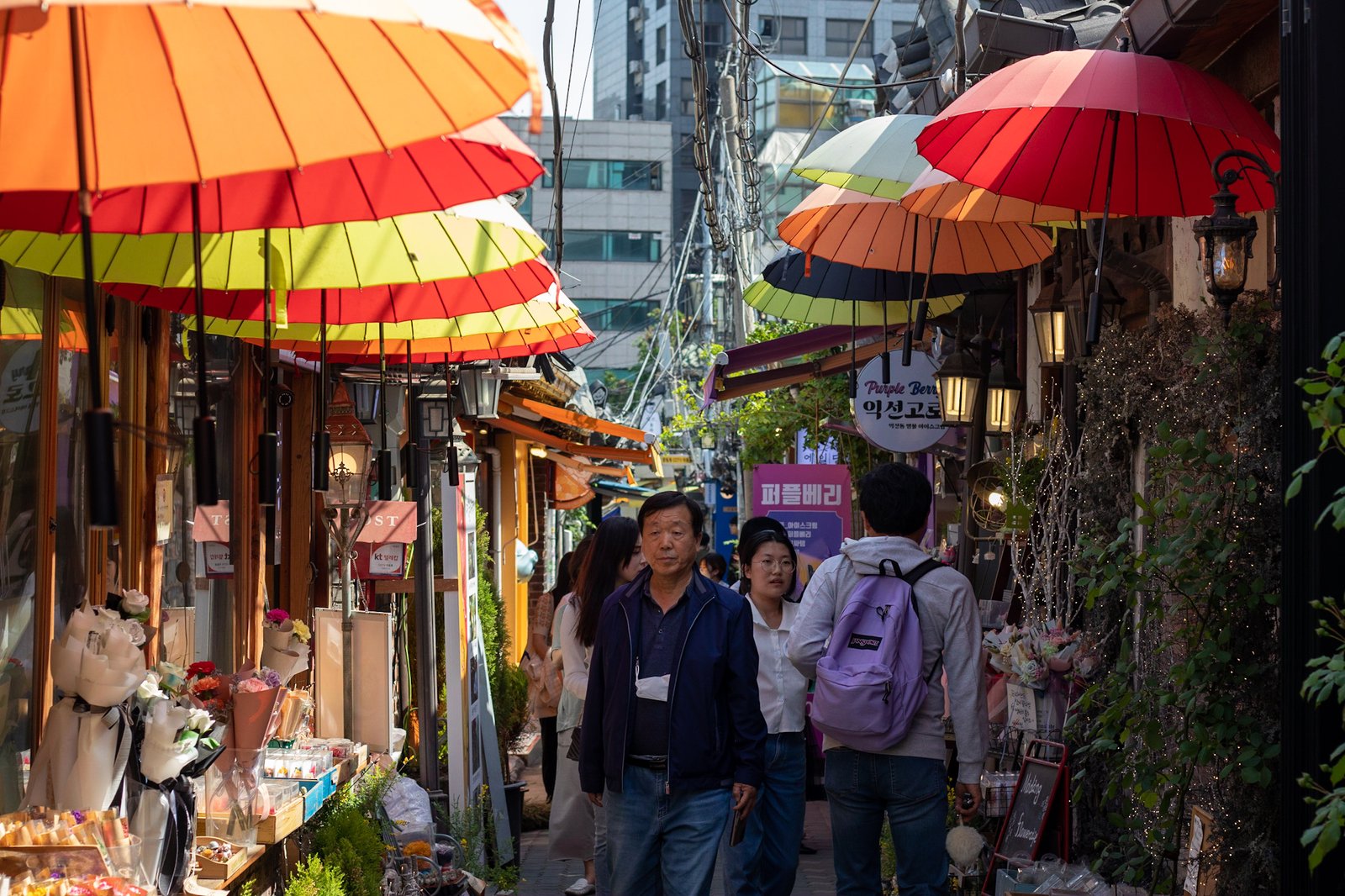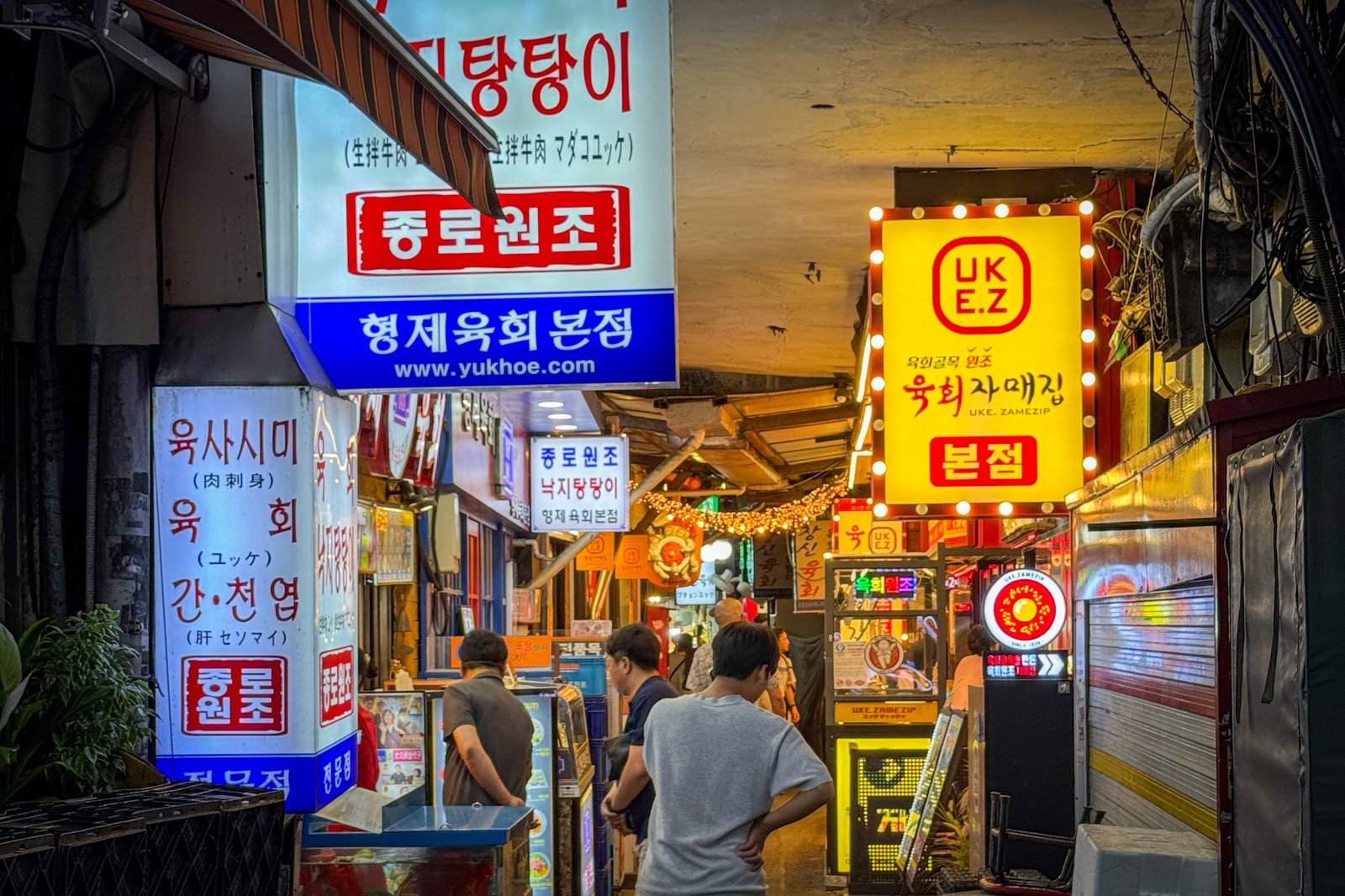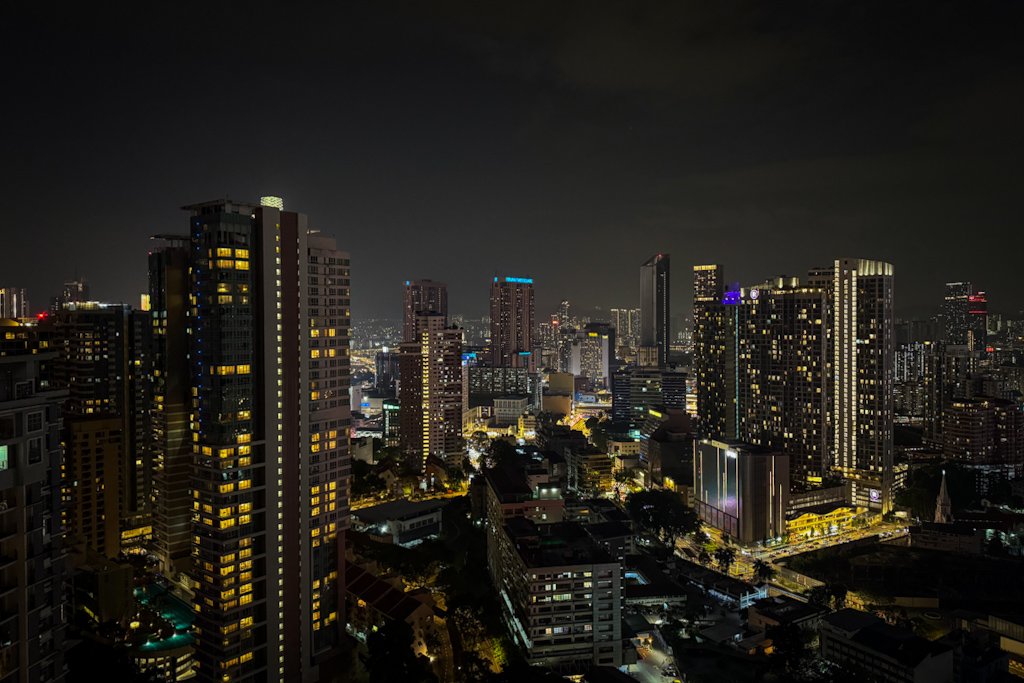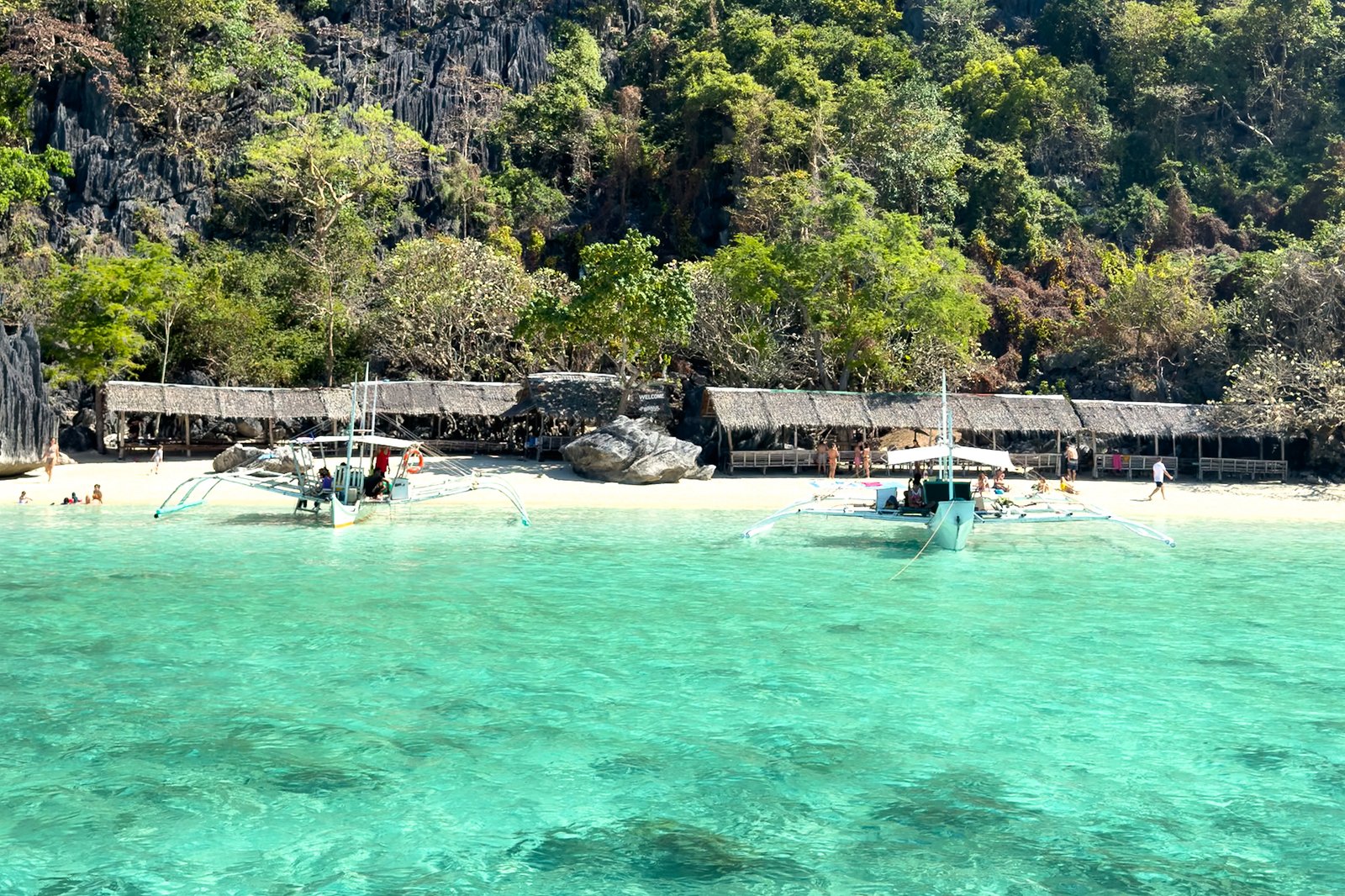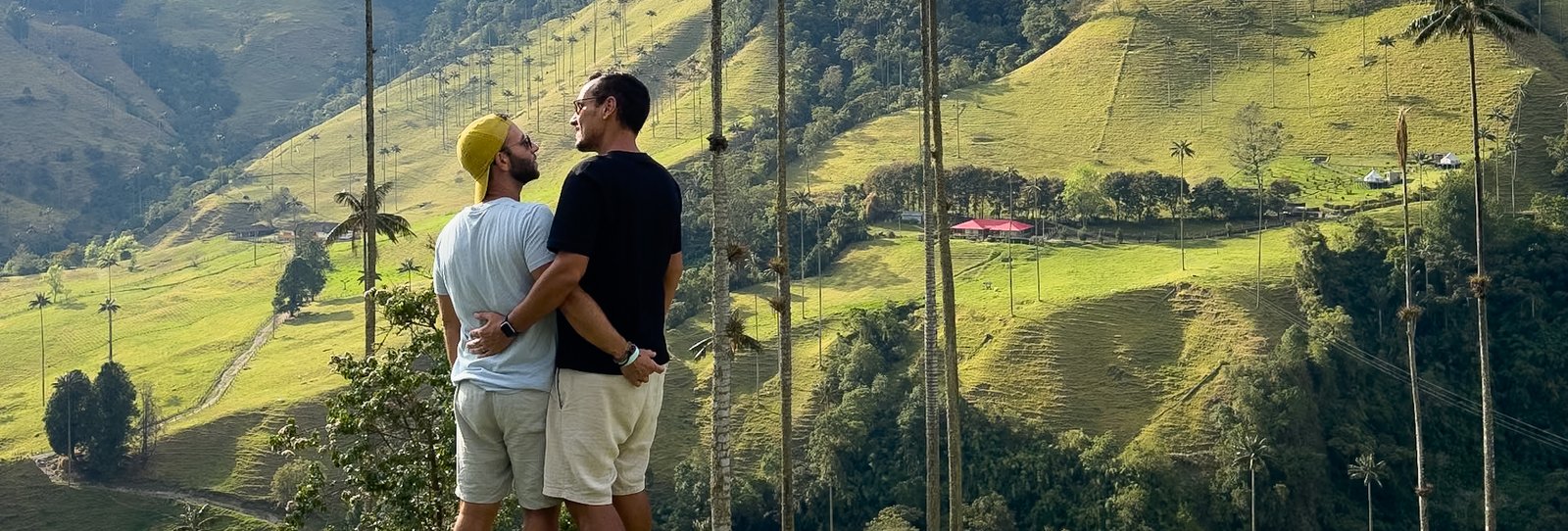Are you planning your itinerary in Jeju? When we were planning the end of our second trip around the world, that familiar traveler’s doubt arose: “Should we go home now or extend our trip a few more days?” We were in Japan, happy but tired, and realized it wasn’t yet time to finish. Instead of flying to the United States as we initially thought, we decided to stay a little longer in Asia — and that’s how Jeju entered our plans.
We had already visited South Korea on a previous trip, but at that time we didn’t include Jeju in our itinerary. This time, with direct flights from Osaka, the decision was easy: it was the perfect opportunity to discover this volcanic island, known for its stunning landscapes, nature trails, hidden waterfalls, and black sand beaches.
And the truth is that Jeju exceeded all our expectations. From the volcanic cones called oreum to the minimalist cafes with sea views, it was the ideal place to disconnect from the world and explore at our own pace.
Table of Contents
If you’re looking for the best areas to stay in Jeju, check out our post with accommodation suggestions on the island
Why Jeju is special — and why you should definitely visit
Jeju isn’t just a pretty island. It’s a destination with its own unique identity, quite different from the rest of South Korea. Here, nature sets the pace: the mist-covered mountains, green tea fields, lava paths along the coast — everything invites you to slow down, stop more often, and breathe deeply.
But Jeju is also special for its traditions. From the haenyeo — female divers who gather shellfish by free diving — to the local food with intense flavors and fresh seafood ingredients, everything made us feel we were in a unique place.
If you’re looking for a destination that combines adventure and relaxation, nature and culture, Jeju is definitely the right choice.
How to explore Jeju: the best way to discover the island
The truth is that Jeju isn’t an island to see in a hurry. It’s large, with points of interest scattered all along the coast and inland, and public transport doesn’t reach everywhere. So after some research and talking with other travelers, we realized the best way to explore Jeju is indeed to rent a car.
That’s what we did: we rented a car for the first few days, which gave us complete freedom to explore less touristy trails, visit hidden waterfalls, and stop whenever we saw something beautiful — and Jeju is full of those unexpected moments.
On the last days, we returned the car and stayed relaxing by the beach, in a quieter area, perfect for recharging our energy before hitting the road again.
How to rent a car in Jeju: practical tips
If you’re also thinking about renting a car in Jeju, there are some important details to know:
- Book in advance: especially during high season, it’s best to arrange the rental ahead of time. We used Klook and DiscoverCars to compare prices and choose the most practical option.
- International driver’s license: in South Korea, an International Driving Permit (IDP) issued in your home country is mandatory. Without it, no rental company will give you a car.
- Driving on the right: just like in Portugal, you drive on the right side of the road, which makes it much easier for those who don’t want to adapt.
- Useful apps: we used Naver Map and KakaoMap, which work better than Google Maps in South Korea.
Oh, and don’t forget that the roads in Jeju are good and easy to drive — even for those not used to big car adventures abroad. The roads have lots of speed control, but that’s also good, as it made us drive more carefully.
Want to see our complete itinerary around Jeju Island? Keep reading — we’ll tell you everything we visited, where we stayed, and how we organized our days by area.
Our Jeju itinerary: 9 days exploring the island at our own pace
We organized our time in Jeju simply and flexibly, dividing our stay into three different areas of the island. Each has its own atmosphere and is ideal for different types of experiences — from wild nature to seaside cafes and peaceful beach days.
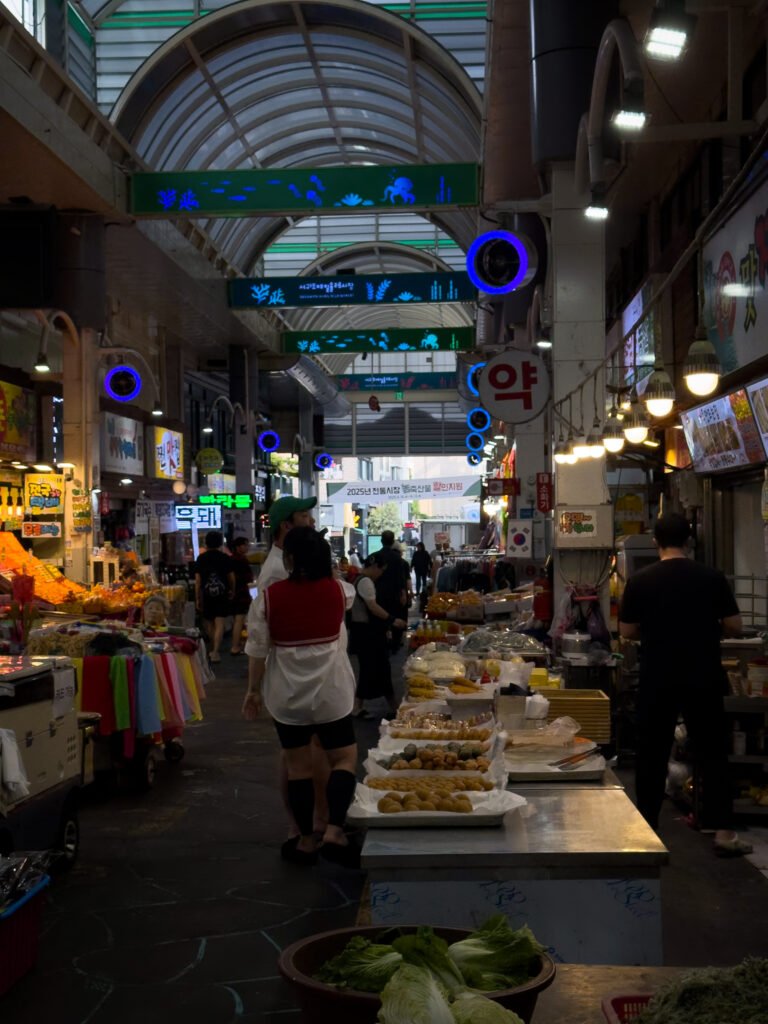

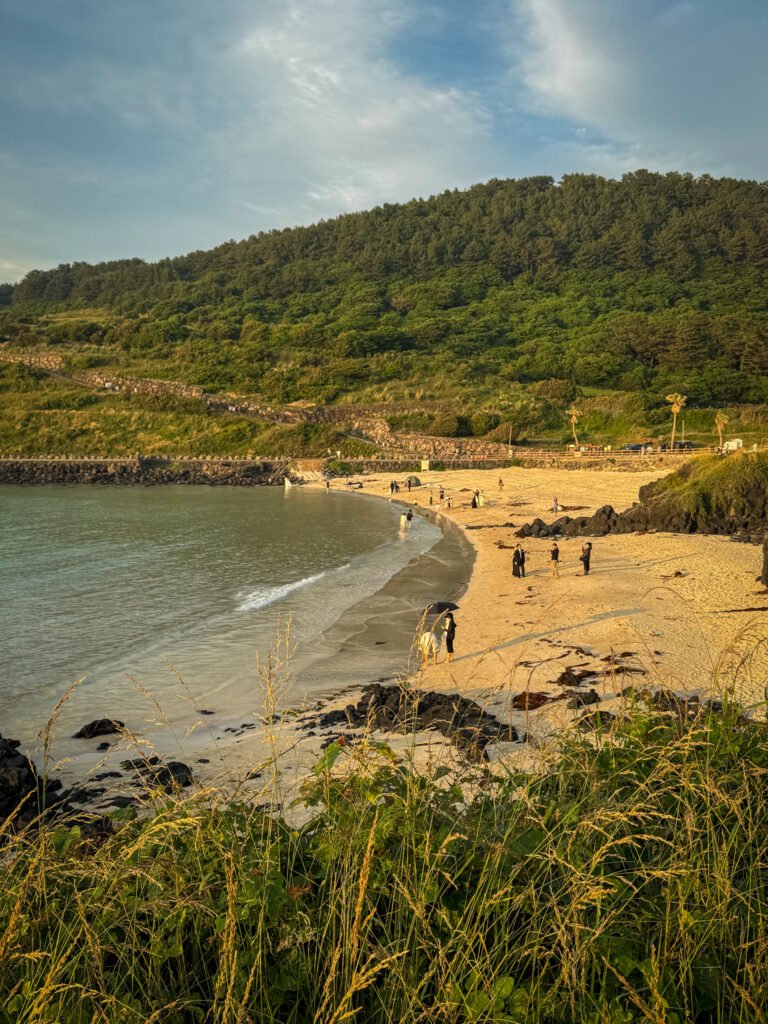
This was our plan:
- Seogwipo – 2 nights
- Jeju City – 2 nights
- Hamdeok – 5 nights
Next, we’ll show you our day-by-day itinerary — what we visited in each area, where we ate, how we got around, and what’s really worth including in your plan.
First stop: Seogwipo (2 nights)
Seogwipo is in the south of the island and was, for us, the perfect starting point. The area is known for its waterfalls, nature trails, and proximity to Mount Hallasan. It was here that we began to feel Jeju’s most authentic and green side.
What to do in Seogwipo and surroundings
After picking up our car at Jeju Airport, we headed straight to Seogwipo in the south of the island. For the first day, we didn’t want to complicate things — the plan was simple: visit Olle Market and try the famous black pork Korean BBQ, a typical Jeju specialty.
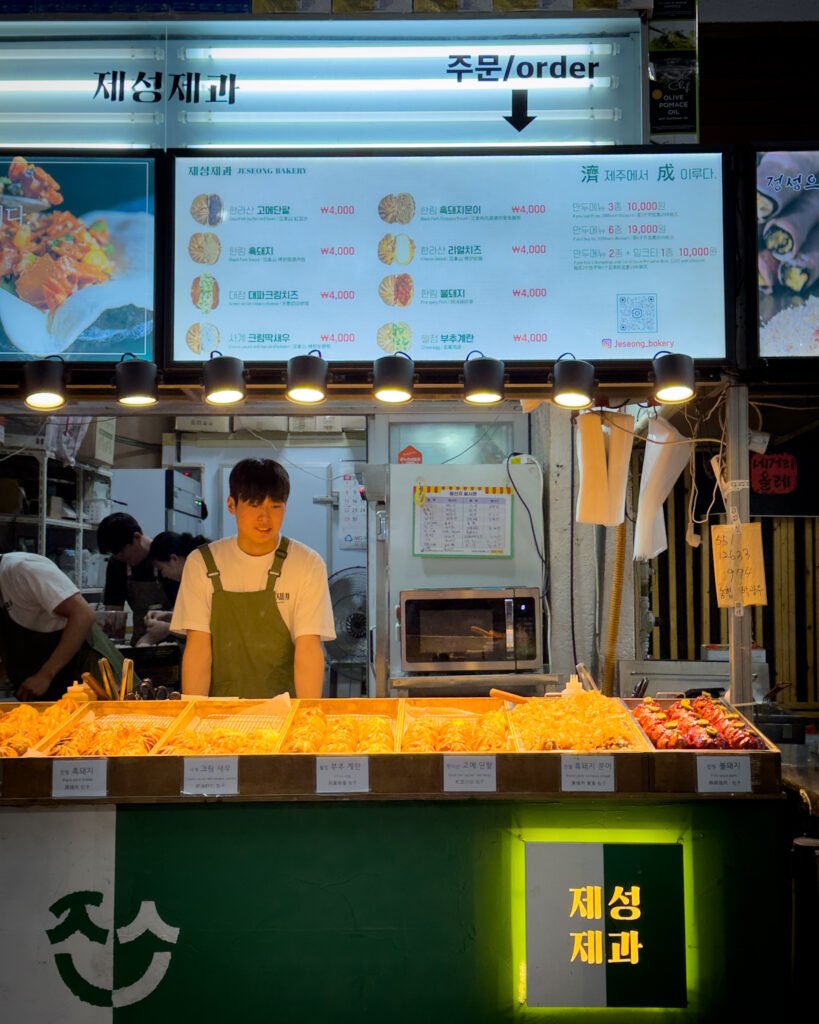
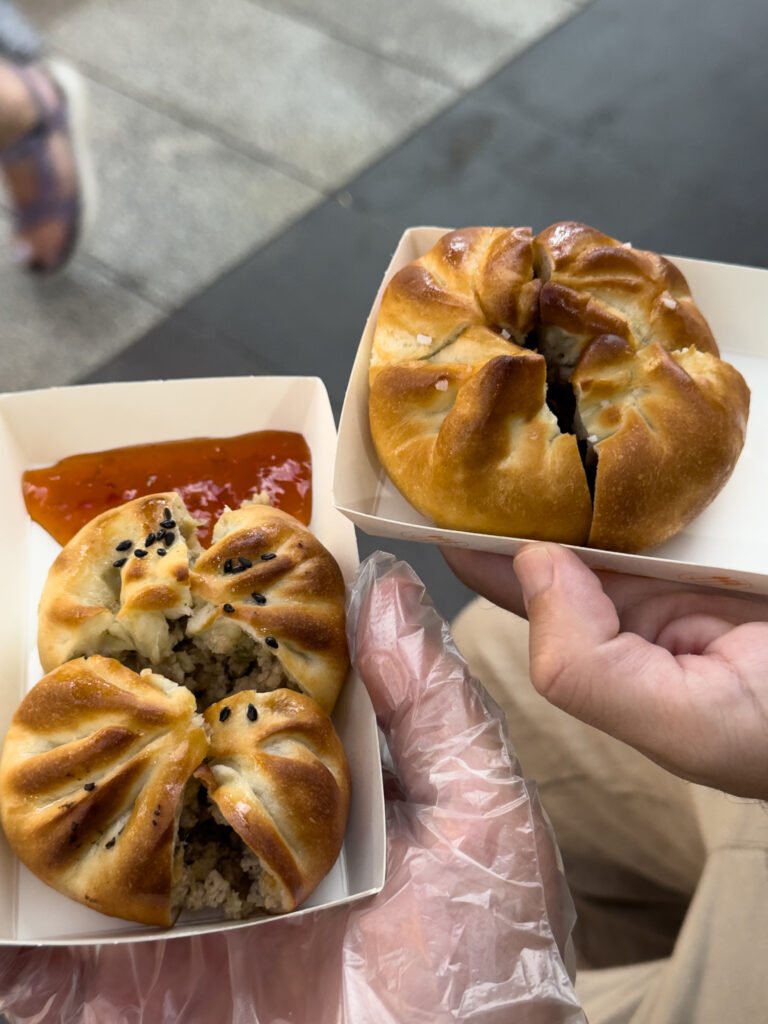
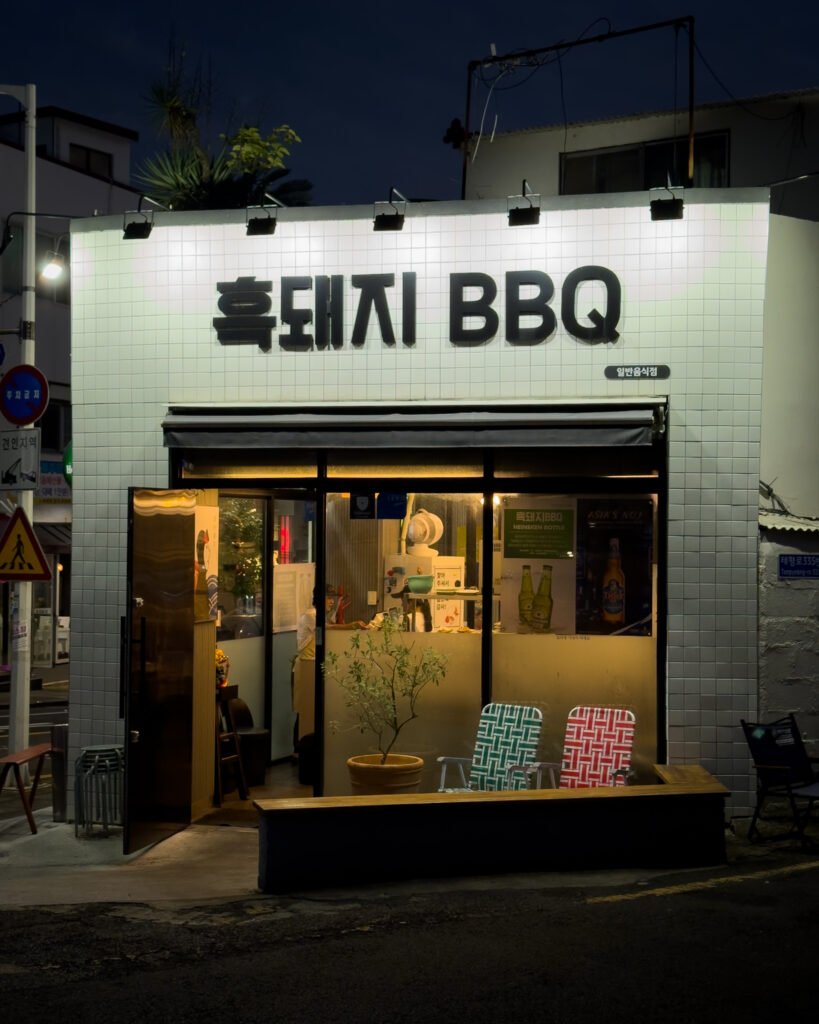
The Olle Market is much more than a fresh fruit and fish market. There are dozens of stalls with street food — everything looking great and full of aromas that whetted our appetite. Jeju is known for its tangerines, and it’s impossible not to notice. We took the opportunity to drink freshly squeezed tangerine juice (super sweet and refreshing) and buy some for the road.
For dinner, we went to Black Pork BBQ, a restaurant known for its meat quality. The grilled black pork at the table came with several banchan (Korean side dishes), all delicious. It was an excellent way to end the day.
We stayed in Seogwipo and used the city as a base to explore the west side of the island on the second day. This part of the island has incredible landscapes, coastal trails, volcanic cliffs, and white sand beaches.
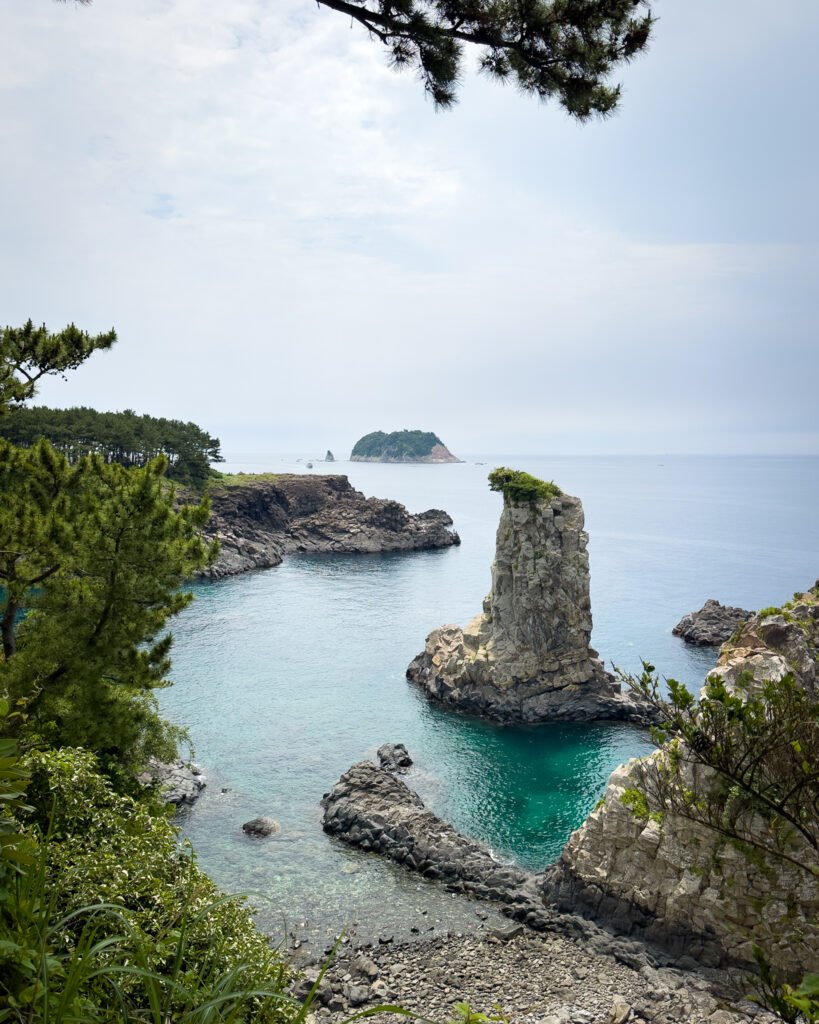
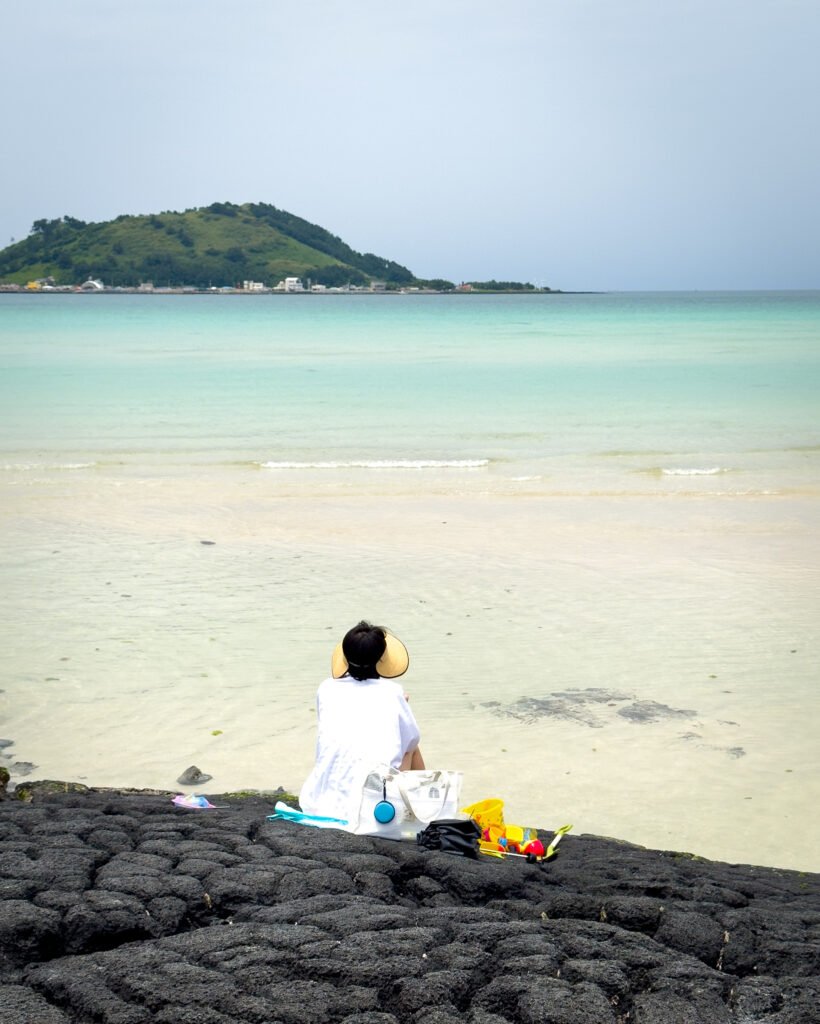
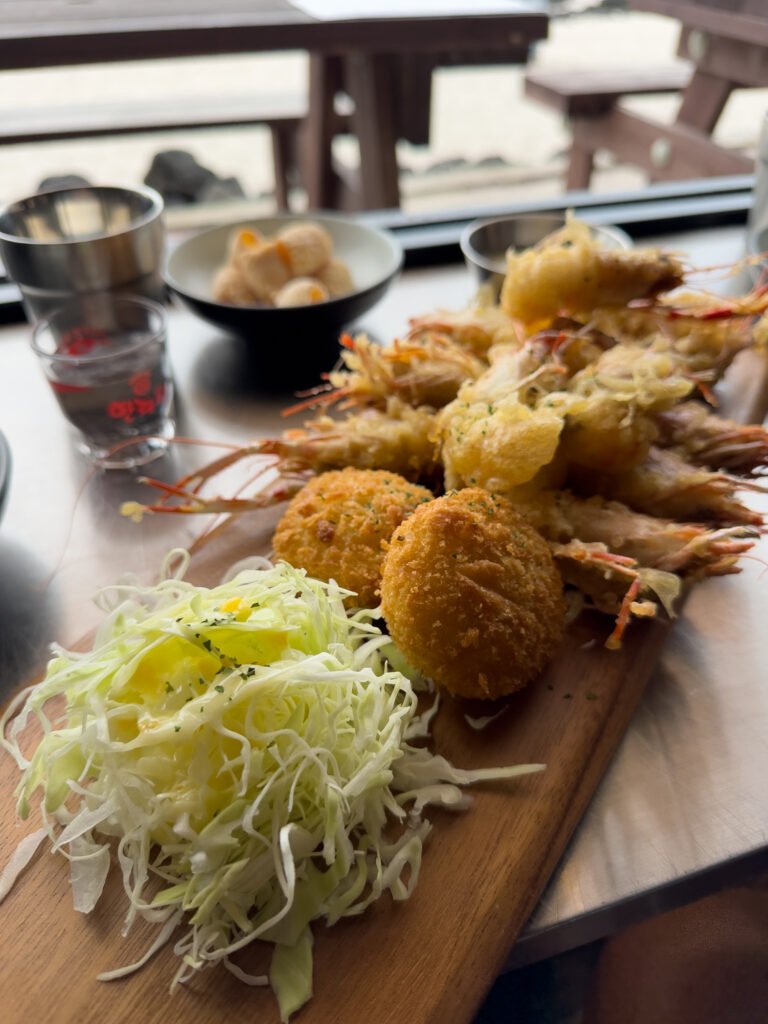
Oedolgae and the Olle Trail
We started the day with a short walk to the Oedolgae rock formation. This area is part of the Olle Trail Course 7, which starts right in Seogwipo. We didn’t do the complete trail — the island has over 27 marked trails that go all around the island — but it was worth passing by, breathing the sea air, and, of course, drinking more homemade tangerine juice.
Hyeopjae Beach and lunch with a view
We then headed to Hyeopjae Beach, one of Jeju’s most beautiful beaches, with white sand and turquoise water. We had lunch at a simple but authentic restaurant right by the sand: Hyeopjae Gogi Bueok. The grilled meat was great, and the relaxed atmosphere with sea views was just what we needed.
Suwolbong, Sanbangsan, and volcanic cliffs
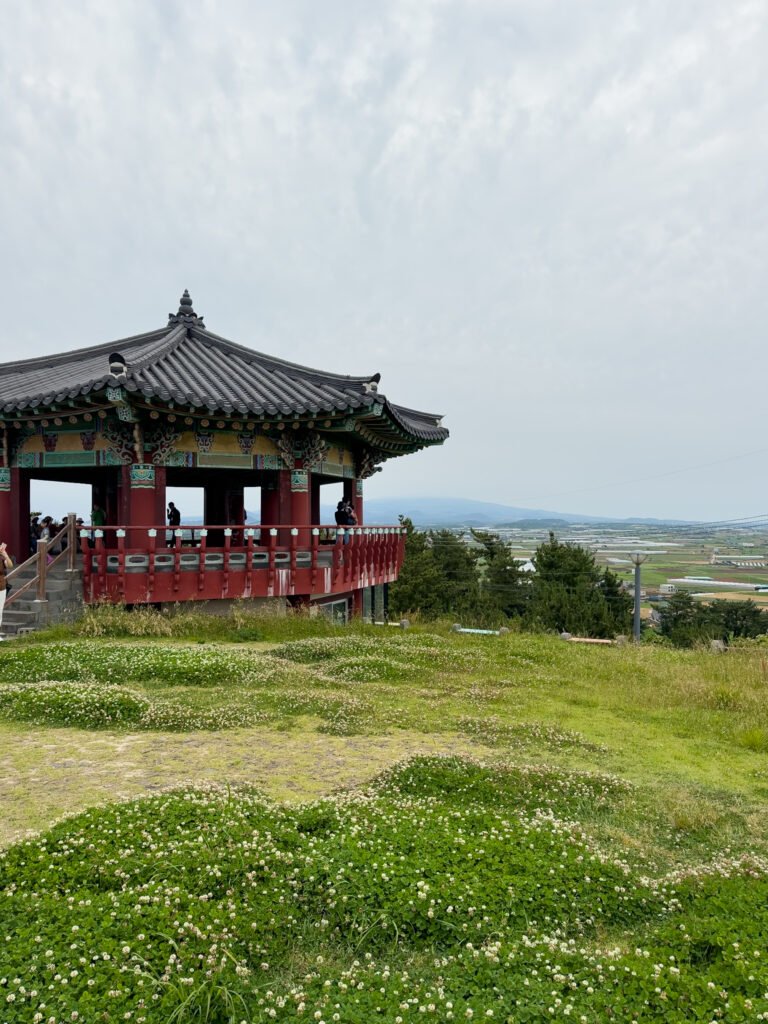
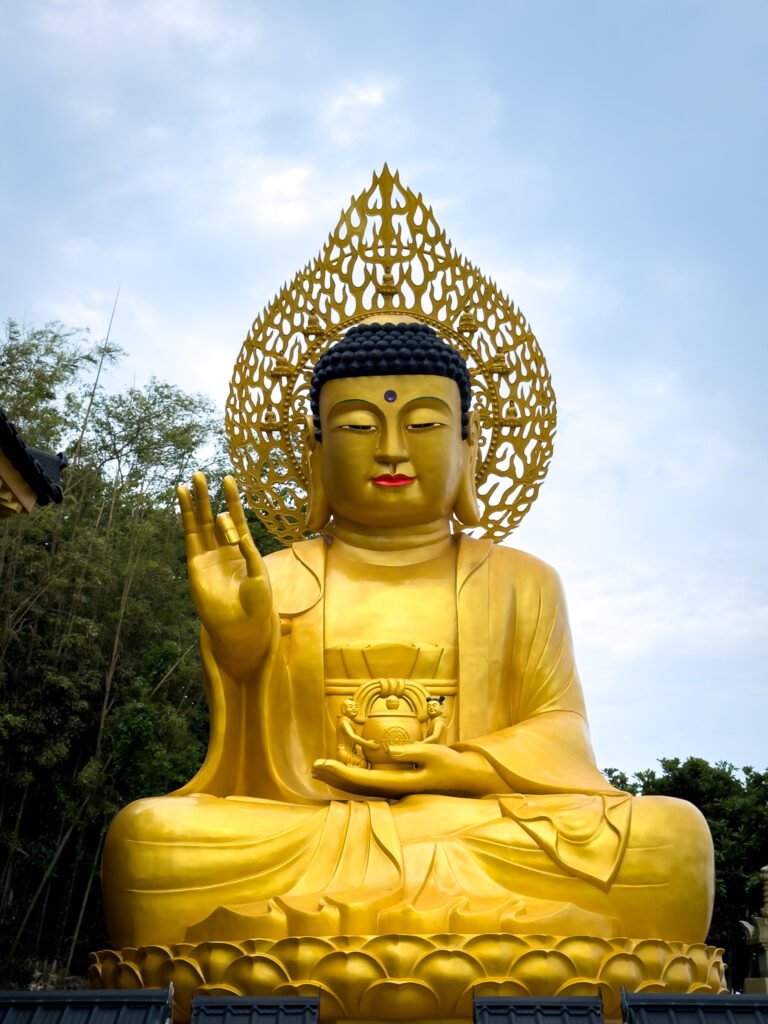

After lunch, we continued exploring:
- Suwolbong Observatory: a hill with panoramic views of the sea and volcanic formations. It’s also part of one of the Olle Trail routes.
- Mount Sanbang and the Buddhist temple embedded in the hillside — a sacred and serene place, with a small cave and sea views.
- Daepo Jusangjeolli Cliffs (Jusangjeollidae): basalt columns formed by lava, similar to the Giant’s Causeway in Ireland. A true natural spectacle.
Jeongbang Waterfall and 서복공원 (Seobok Park)
Returning to Seogwipo, we also visited Jeongbang Waterfall, one of the few waterfalls in Asia that falls directly into the sea. The water’s force, the view, and the sound of the waves make this place truly special.
We ended the day with a quick stop at Seobok Park (서복공원), dedicated to a legendary Chinese figure associated with the search for immortality. Even if you don’t know the story, the park is pleasant for a walk and has good viewpoints.
Where to stay in Seogwipo and surroundings
In Seogwipo, we stayed at Hotel Winstory, a very practical option for those who, like us, want to explore the south of the island without spending too much. The location convinced us — close to local restaurants, markets, and with easy access to the area’s main natural attractions, like waterfalls and coastal trails.
The room was spacious, with a small kitchenette that was very useful for preparing breakfasts and snacks. Free parking was also a plus, as we had a car and it made getting around much easier.
If you’re planning your trip and want to see other accommodation suggestions, check out our article on where to stay in Jeju — there we gathered the best hotels by area, including options in Seogwipo, Jeju City, and Hamdeok, for all budgets.
Second stop: Jeju City (2 nights)
After Seogwipo, we headed to the north of the island and stayed two nights in Jeju City. Here the atmosphere is more urban, with local markets, museums, and a good base for exploring the oreum (volcanic cones) in the central area.
What to do in Jeju City and surroundings
We left Seogwipo early heading to Jeju City, but we didn’t go straight there. We took the day to visit some of the island’s most beautiful spots before reaching the city. This route is ideal for those who want to explore natural landscapes, local culture, and good food, all in one day.



Seongeup Folk Village
The first stop was Seongeup Folk Village, a traditional village that preserves old houses from the Joseon era. We walked along the stone streets, saw houses with thatched roofs, and met some locals who still live there, maintaining traditions lost in other parts of Korea. It was an incredible way to immerse ourselves in Jeju Island’s history.
Seopjikoji
We then headed to Seopjikoji, one of Jeju’s most photogenic coastal areas. The landscape mixes green fields, dramatic cliffs, and the intense blue of the sea. We walked to the lighthouse, with the wind in our faces and breathtaking views. This place is truly special, especially if you love nature and the sea.
Seongsan Ilchulbong (Sunrise Peak)
The next stop was Seongsan Ilchulbong, an ancient volcanic cone known as Sunrise Peak. It’s one of the island’s symbols and one of the best spots to watch the sunrise. We didn’t climb to the top this time, but just seeing the imposing formation from afar was worth the visit.
Tasty stop at Seogwipean Bakery
Before continuing our journey, we stopped to eat at Seogwipean Bakery. The bakery has an incredible sea view, and everything we tried was delicious. It’s a great place for a midday break, with cakes, artisanal bread, and a very welcoming atmosphere.
Sangumburi (canceled due to rain)
We had planned to visit the Sangumburi crater, but it started raining heavily, and we ended up moving on. Next time! Still, it’s worth including this place in your itinerary — it’s a volcanic crater covered in vegetation, very different from the island’s other formations.
Exploring Jeju City at night
Already in Jeju City, we went straight to Jeju Dongmun Market Food Street, a lively market where you can try various island specialties, from fresh seafood to traditional snacks. At night, we walked along Sanjicheon, where there are light and water shows illuminating the stream — it was a very pleasant surprise!
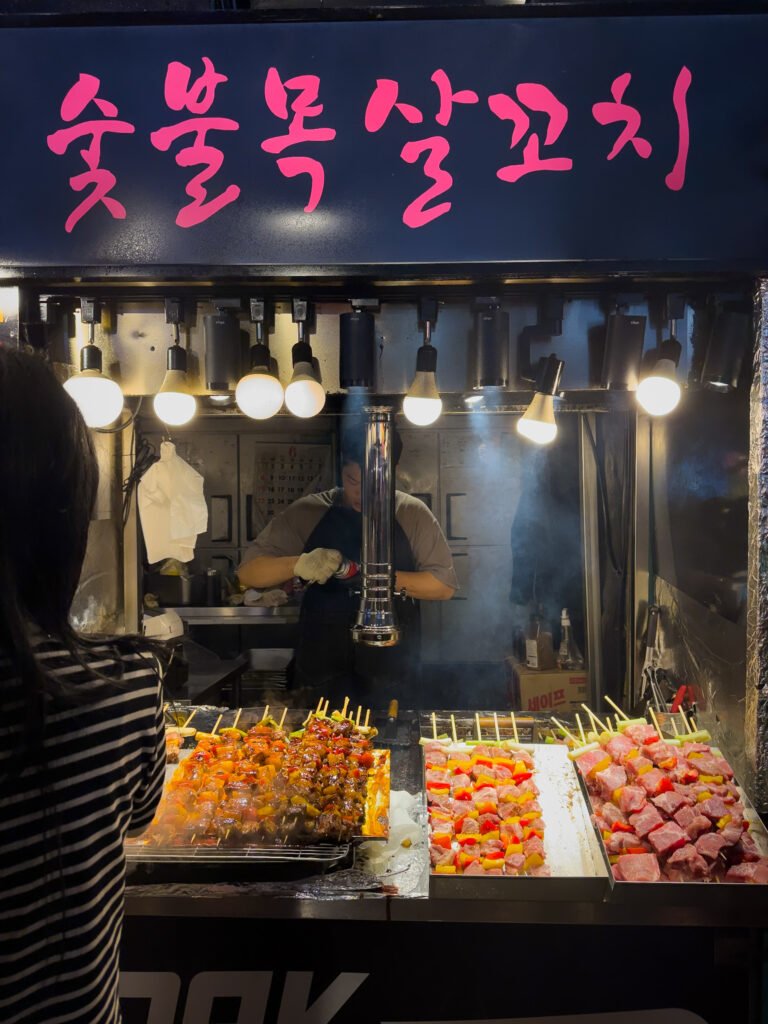
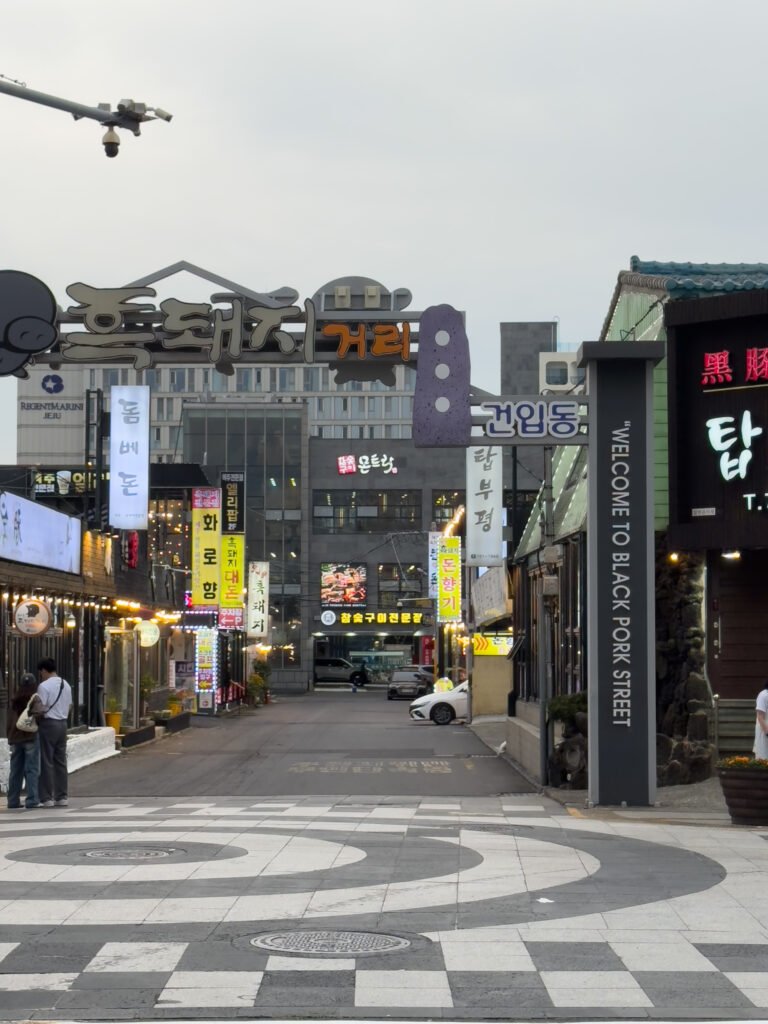
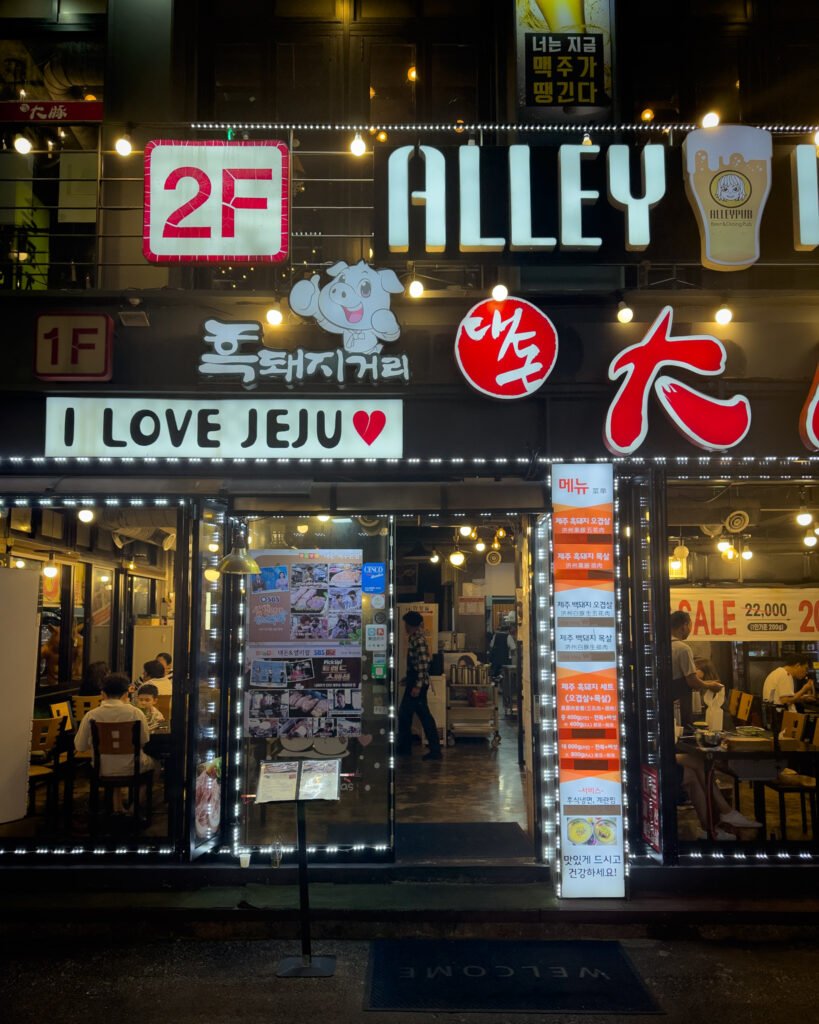
We also explored the shopping area of Chilsungro Shopping Town, with various local shops and some international brands. To end the day, we had dinner at the famous Black Pork Street. We chose the restaurant 대돈 제주본점 (Daedon Jeju Bonjeom), one of the most well-known in the area. The meat was incredible, perfectly grilled, and the Korean BBQ experience was really fun and tasty.
Digital art at Arte Museum Jeju
The next day, we started with a visit to Arte Museum Jeju, an immersive exhibition space where light, sound, and nature merge in rooms that feel like parallel worlds. It was a calmer, more introspective moment of the trip, perfect for getting lost among digital forests, infinite reflections, and impressive visual effects. It’s really worth reserving an hour or two to explore at leisure.
Cafés with views at Aewol Cafe Street
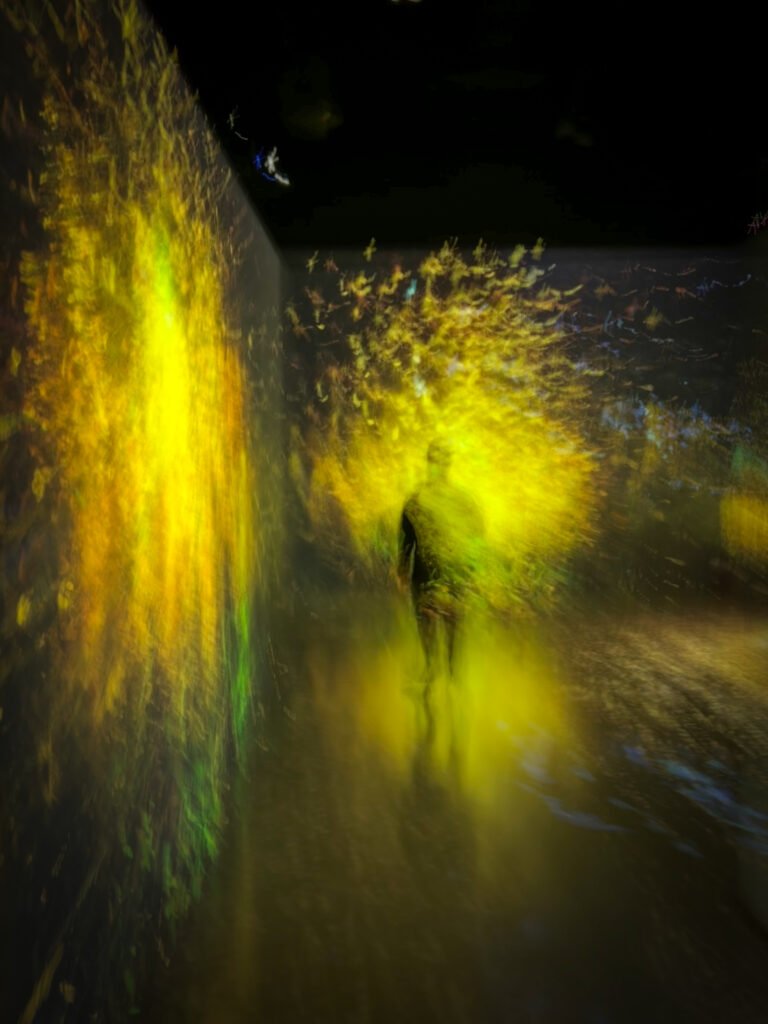
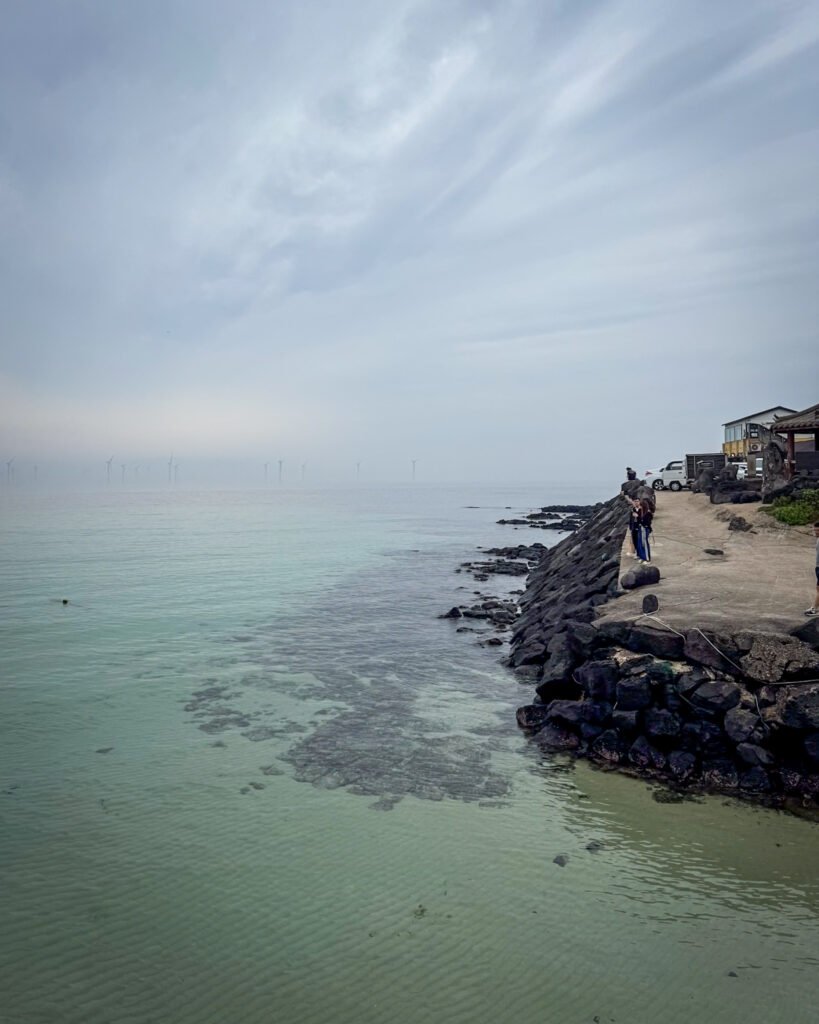
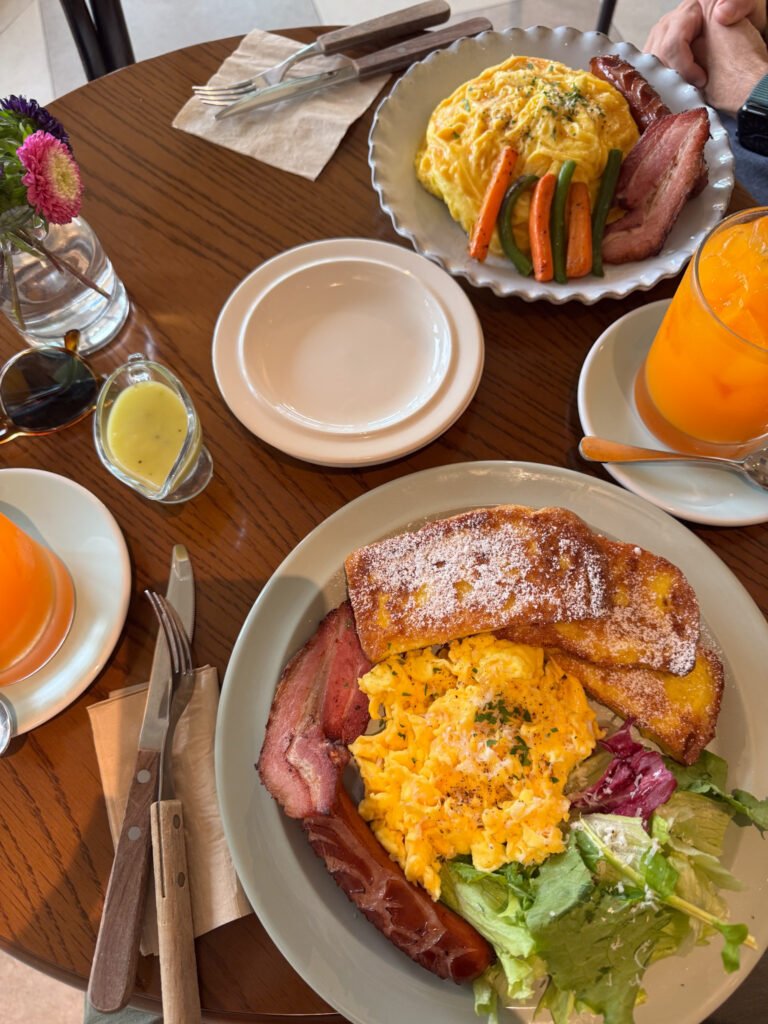
We then followed the coastal road of Aewol, stopping at one of the many cafés with sea views. The area is known for its minimalist architecture cafés, creative bakeries, and ocean-facing balconies. We chose to have lunch at Colline Jeju, a restaurant with a greenhouse-like atmosphere, tables among plants, and a sea view. The space is very photogenic, and the food matches the ambiance: fresh dishes, well presented, with a local touch. It’s the kind of place that combines good taste, flavor, and tranquility — ideal for a leisurely lunch.
Dreamy desserts at Cheongsudang Jeju
We ended the afternoon at Cheongsudang Jeju (also on Aewol Cafe Street), a garden café inspired by the famous space in Seoul but much calmer and without queues. The interior is covered in bamboo, and the atmosphere is zen, almost like being in a modern temple dedicated to pastries. We tried a green tea dessert and the traditional soufflé, beautifully presented. It was the perfect ending to a day full of contrasts — between nature, art, and sweet moments.
Stylish stop at Cafe Urban Brewing
Upon arriving in Jeju City, we took a break at Cafe Urban Brewing, a cool spot with very tasty coffee. If you’re nearby, don’t miss it.
Living history at Gwandeokjeong
One evening, there was a concert at Gwandeokjeong, one of the island’s oldest historical buildings. We couldn’t pass by without entering. Built in the 15th century, this pavilion served as a military training ground and still impresses with its traditional architecture and serene atmosphere. It’s right in the city center but conveys surprising calm — as if it were a small refuge from the past in the midst of modern life. It’s worth stopping by and imagining what Jeju was like centuries ago.
Where to stay in Jeju City
In Jeju City, we chose to stay at Jeju Seomun Residence Hotel. The location was really convenient — close to Dongmun Market and several restaurants, which made our days much easier when we didn’t want to drive anymore. It was a good base for exploring the northern part of the island and resting in a more urban environment.
The hotel had a simple but comfortable atmosphere, with a clean and functional room, ideal for those who spend the day out and just need a quiet space to sleep and organize plans for the next day. We also liked having access to laundry in the building — a precious help in the middle of a long trip.
If you’re looking for other accommodation options in the area, take a look at our article on where to stay in Jeju, where we share various hotel suggestions in Jeju City and other areas of the island, with alternatives for all tastes and budgets.
Third stop: Hamdeok (5 nights)
We saved the last days for relaxing by the sea — and we couldn’t have chosen better. Hamdeok, on the northeast coast, is known for its turquoise waters and tranquil atmosphere. It was here that we slowed down and took time to write, walk, and recharge.
What to do in Hamdeok and surroundings
After a few busy days exploring Jeju by car, it was time to slow down. We left Jeju City heading to Hamdeok, but first we made one last stop in New Jeju City, where we would return our rental car.
Since we still had some time, we took a walk along Nuwemaru Street, a pedestrian street full of shops, cafés, and a youthful atmosphere. It’s a good place to stroll without rushing, buy some souvenirs, or simply observe the comings and goings of people. Nearby, we tried the famous Korean fried chicken at BHC치킨 연동점, one of those places where the crispy chicken really lives up to its reputation.
The idea of spending five days in Hamdeok came up precisely because we wanted to stop, relax by the beach, and stay somewhere where it was easy to walk. We wouldn’t have a car anymore, so we looked for an area with some movement — restaurants, cafés, a good beach — but without the bustle of a big city. And we found just that. Hamdeok has the right balance between tranquility and local life. You can go out for a walk by the sea, choose a café with ocean views, or even do a light trail, all just a few minutes’ walk away.
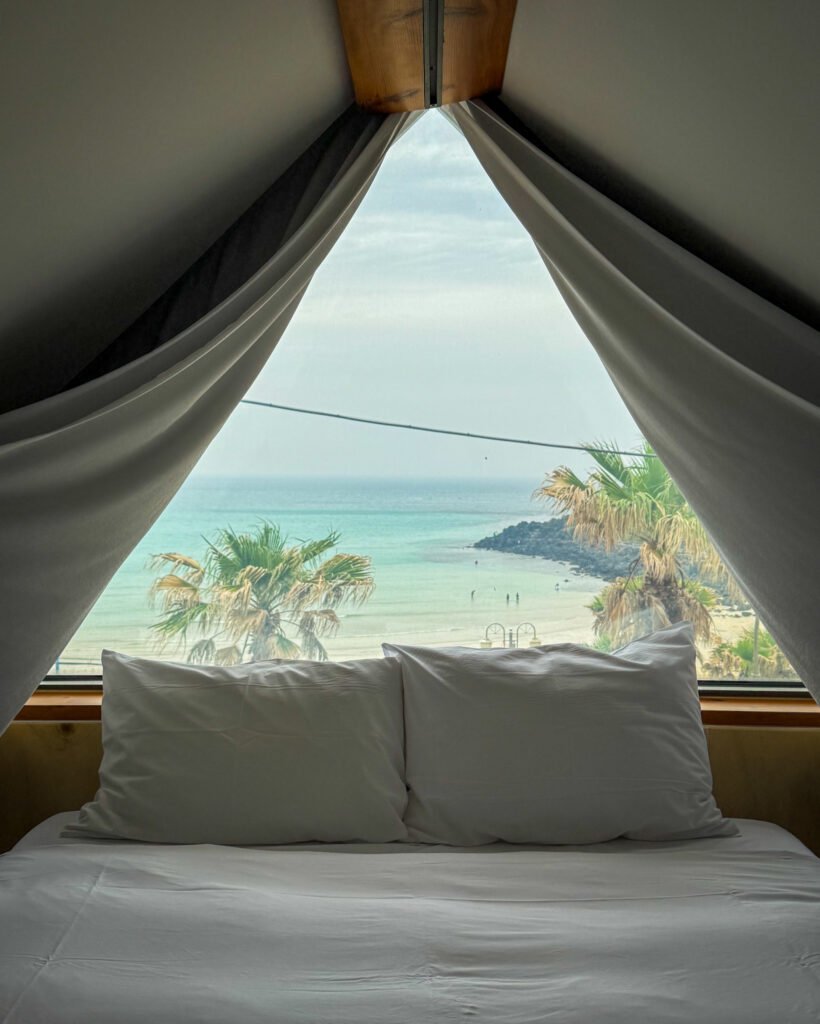
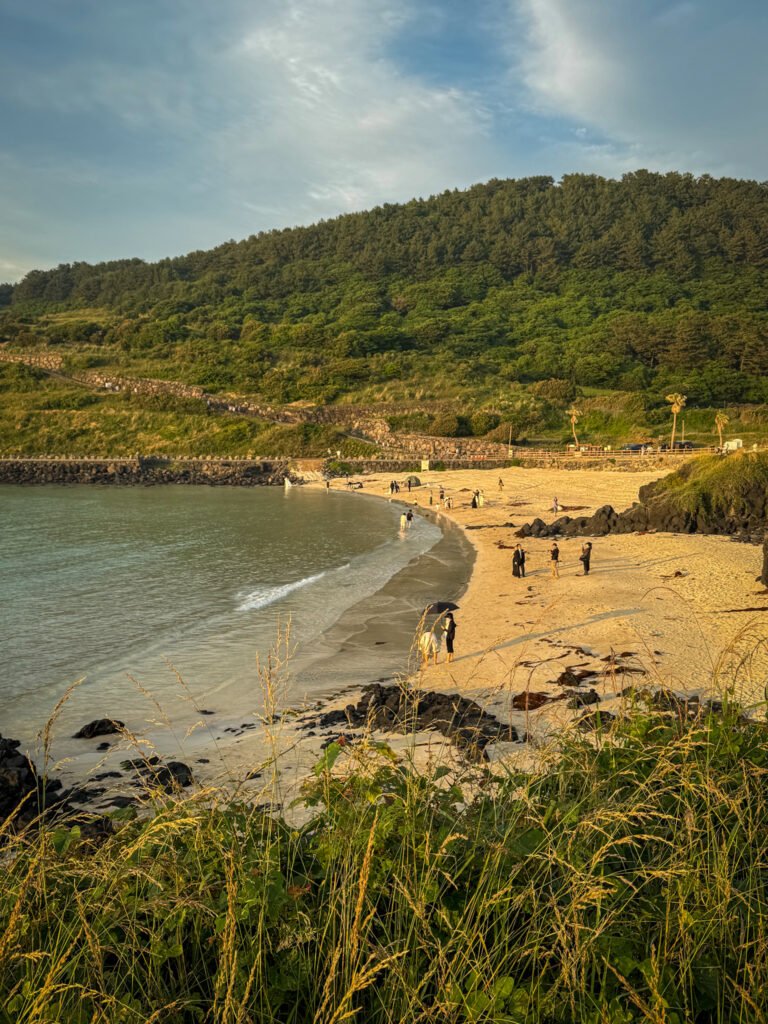
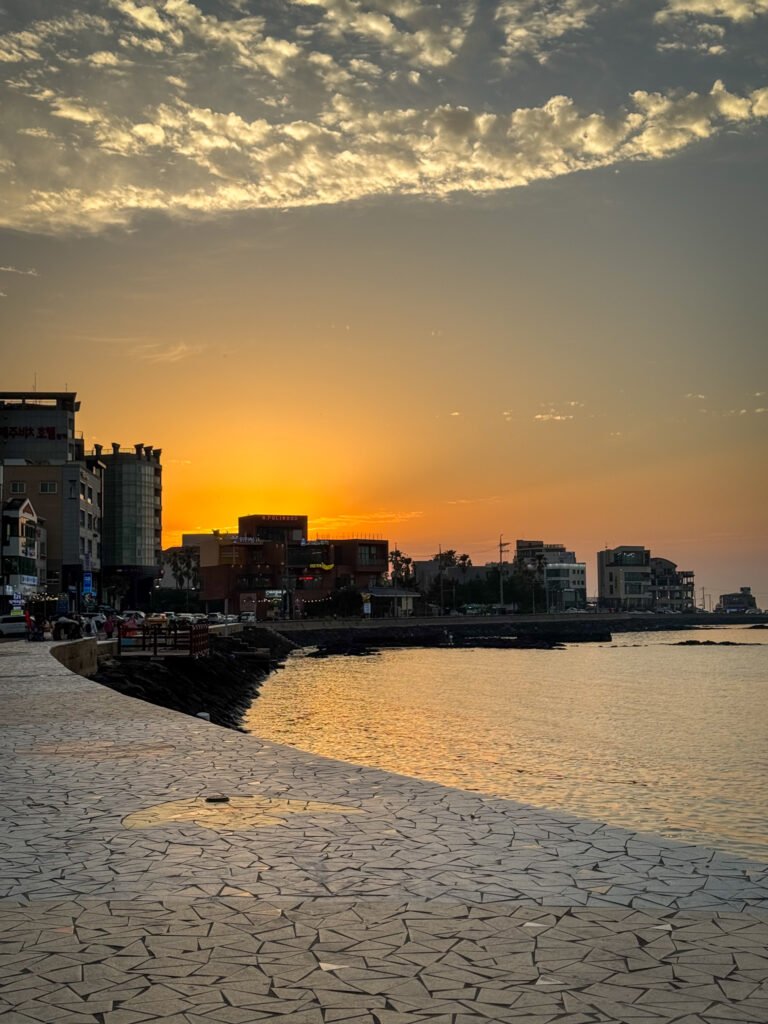
Hamdeok Beach (함덕해수욕장)
Hamdeok’s main attraction. The waters are clear, calm, and shallow — perfect for a swim or simply laying out a towel and relaxing. On the east side of the beach (동쪽해변), the atmosphere is more tranquil, and the landscape more natural.
Hamdeok Viewpoint (함덕해수욕장 전망대)
Right by the beach, this small viewpoint offers an incredible view of the bay. Ideal for those who love photography or simply watching the sunset.
Walking along Johamhaean-ro waterfront
It’s along this waterfront that Hamdeok’s movement is concentrated: restaurants, cafés, shops, small markets, and lots of people strolling. A great place to feel the local rhythm, especially in the late afternoon.
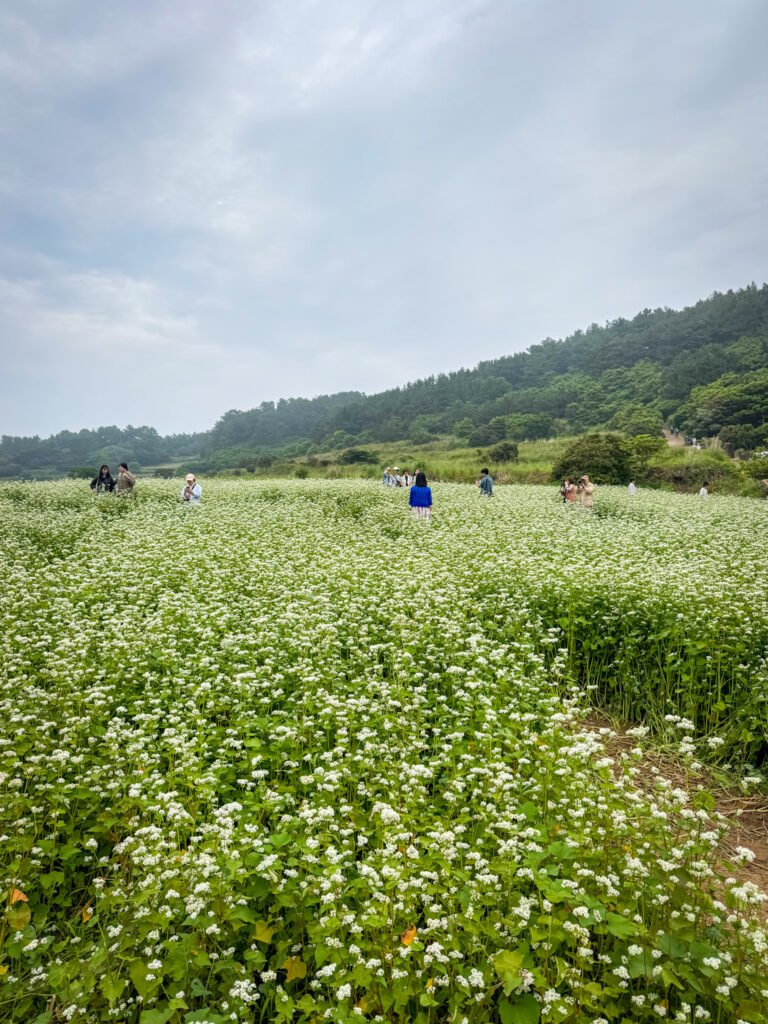
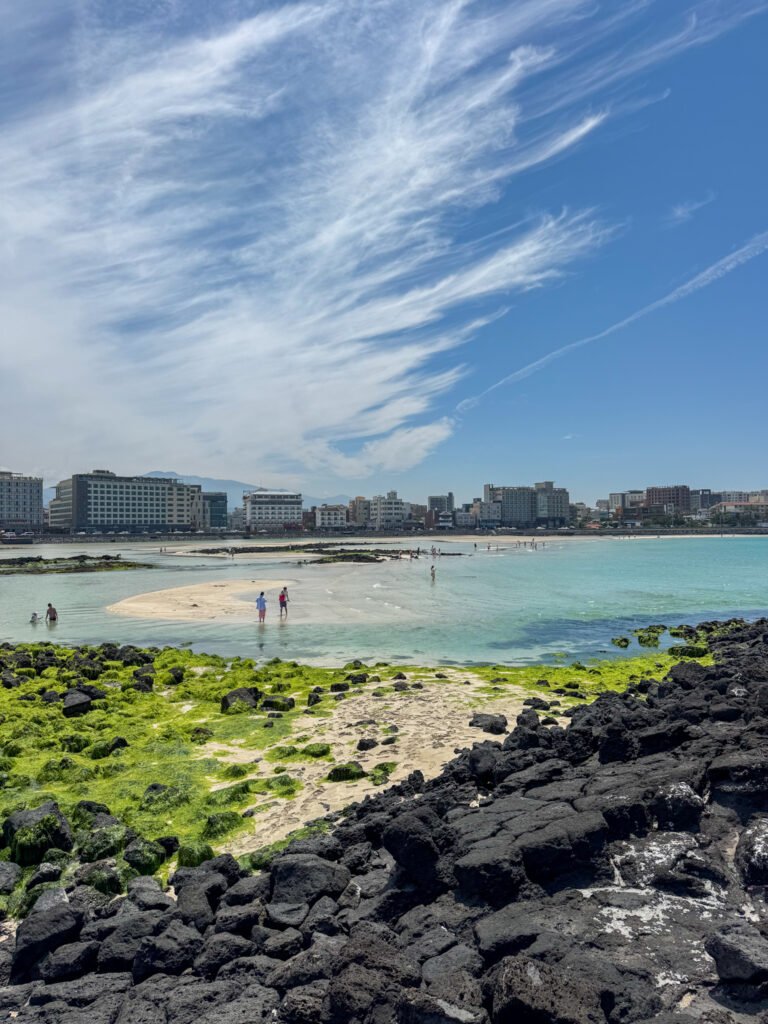
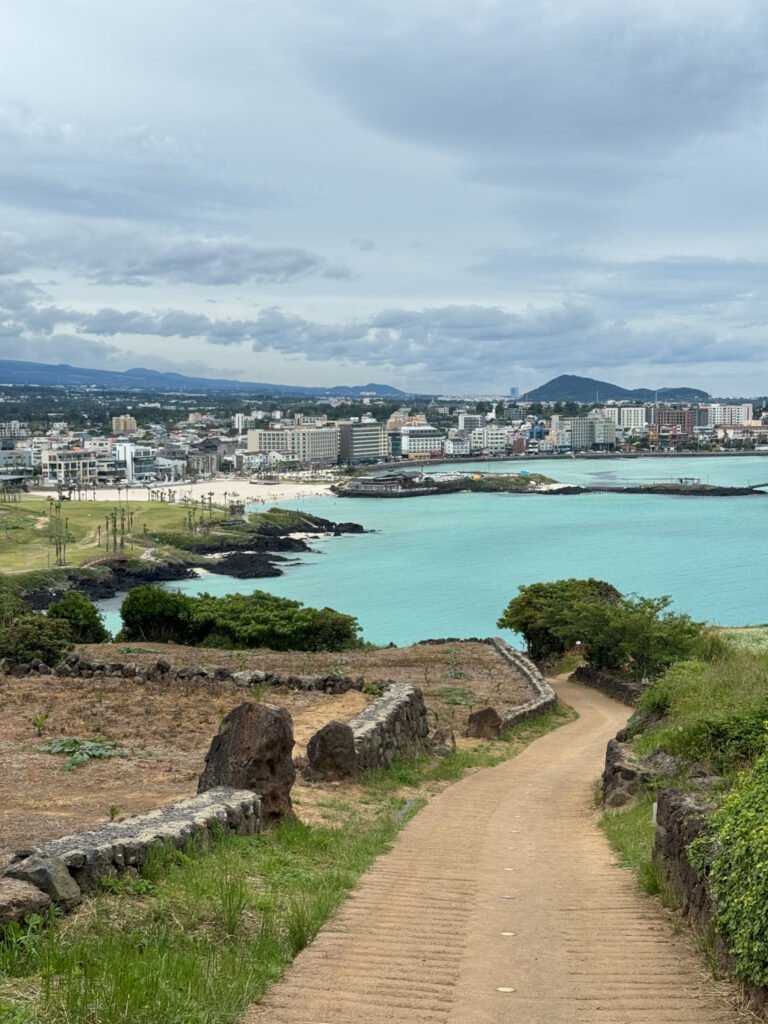
Seoubong Trail
An easy and accessible trail that starts near the beach and climbs to the summit of Mount Seoubong. From the top, you have a panoramic view of Hamdeok and the ocean. Worth the effort, especially on a clear day.
Danish Bakery
A cozy bakery with artisanal bread, ideal for a more European-style breakfast. They also serve specialty coffee.
Roller Coast
A modern café with good music, careful décor, and sea views. A good place to read or work quietly.
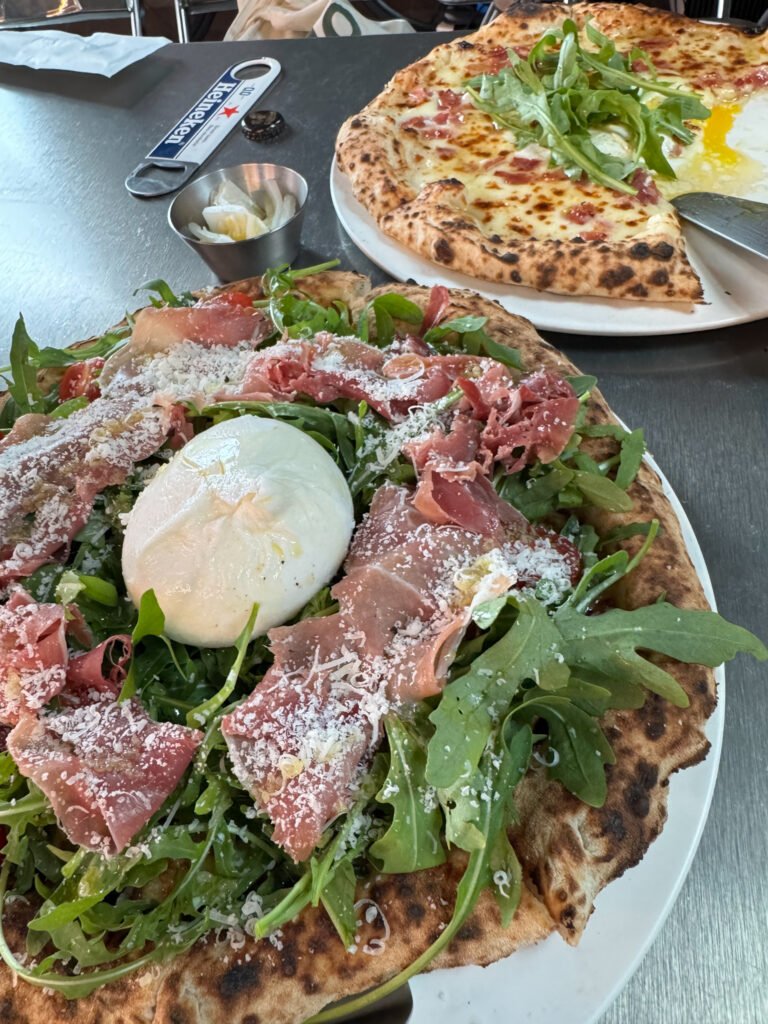
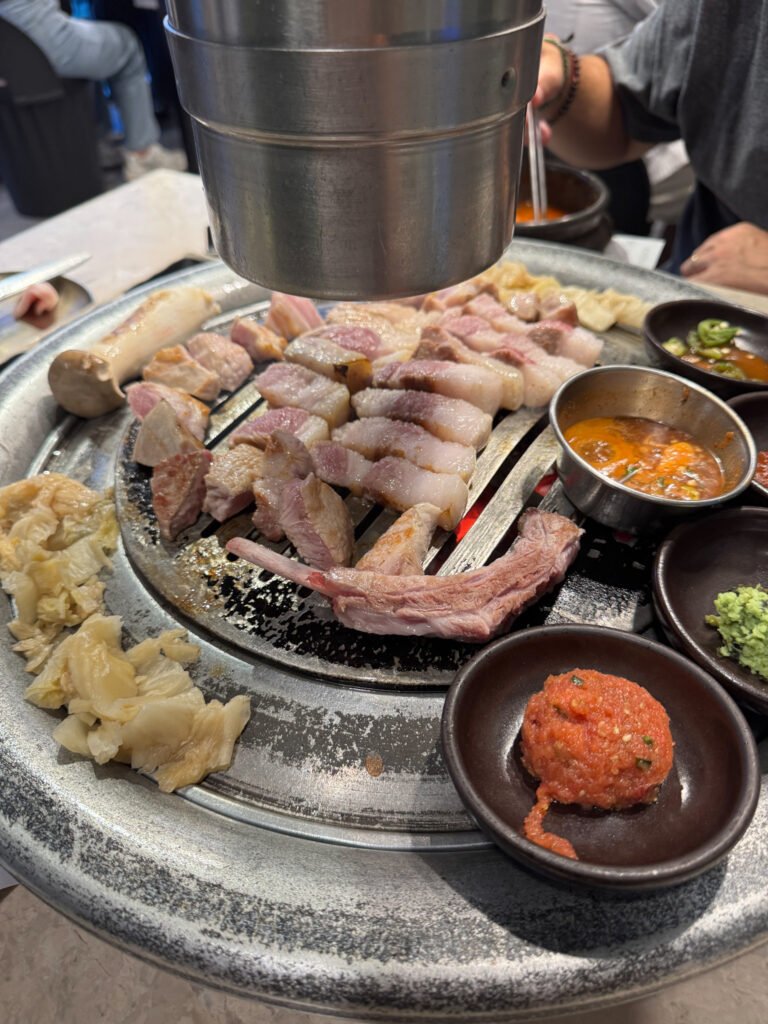
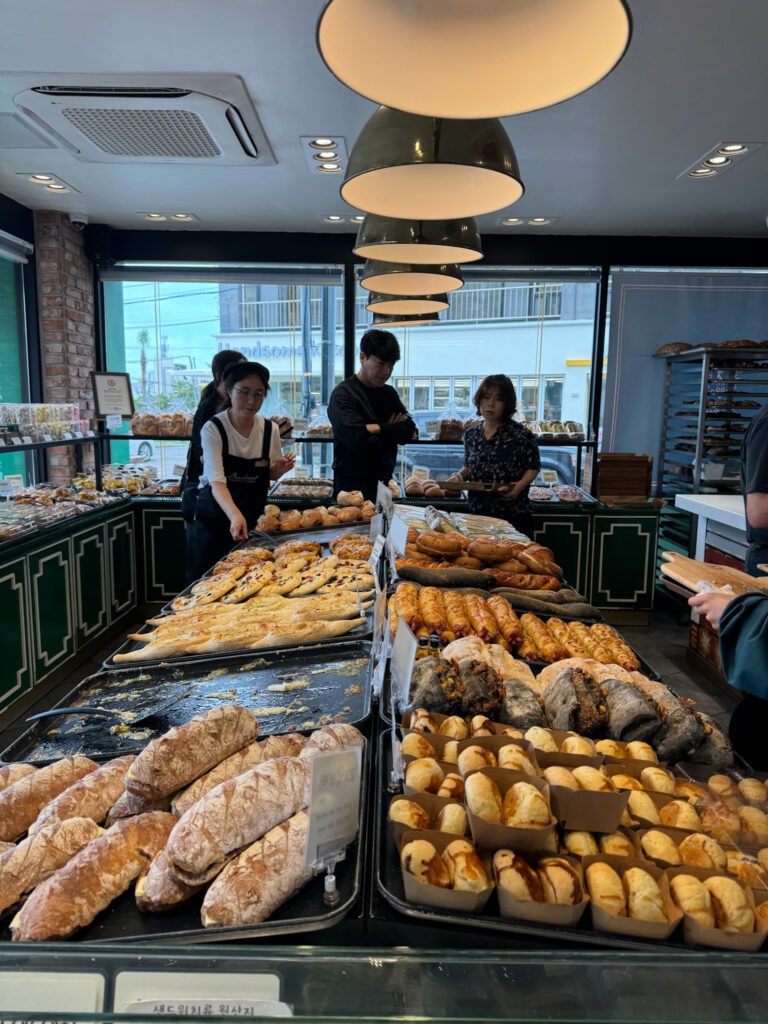
Cafe Del Moondo
One of Hamdeok’s most iconic cafés, built literally on the rocks by the sea. The setting is incredible, and the atmosphere becomes magical by the end of the day.
교촌치킨 함덕점 (Kyochon Chicken)
Korean fried chicken at its best. This chain is a classic, and the Hamdeok location is perfect for an informal dinner after the beach.
Melts in Villages (멜츠인빌리지)
A relaxed restaurant with creative dishes, burgers, and snacks. Popular among local youth and with a vibrant atmosphere.
Sugseongdo Hamdeok
More traditional, with authentic Korean dishes and affordable prices. A good option to try local flavors in a simple setting.
N.POLIWood
A tranquil café, ideal for a break with a view and a sweet treat. They also serve brunch and fresh drinks.
Audrant Bakery
One of the city’s best bakeries — it’s impossible to pass by without noticing the smell of freshly baked bread. Don’t miss the red bean paste and butter bread.
Where to stay in Hamdeok
In Hamdeok, we really wanted to relax by the beach — and Yaho Beach House was exactly what we were looking for. It’s just a few steps from the sea, in a tranquil area, perfect for the last days of the trip. The atmosphere is simple and laid-back, and we immediately felt at home.
We woke up to sea views, had breakfast on the balcony, and then walked to the beach. It was the ideal place to slow down, write, walk along the coast, and enjoy the ocean-view cafés in the area.
If you prefer other options or are looking for something more luxurious or with different services, you can check out our article with tips on where to stay in Jeju, where we gathered suggestions in Hamdeok, Seogwipo, and Jeju City, all with strategic locations and good reviews.
Is this itinerary worth it?
For us, this division made perfect sense. We started with nature and trails, moved through a more urban environment, and ended with beach days. Alternating between areas helped us see different sides of the island without constantly packing and unpacking.
If you have 9 or 10 days in Jeju, we recommend this type of itinerary — it lets you see a lot without rushing, with time to stop and absorb the island’s unique atmosphere.
Tips for traveling in Jeju
- Rent a car in advance — In Jeju, almost everyone rents a car. Public transport is limited, and vehicles sell out quickly, especially during high season.
- Driving on the island takes longer than it seems — There are many traffic lights, low speed limits, and lots of radar control. Always allow more time than expected.
- Plan your routes well — Even if distances seem short on the map, journeys take time. Good daily planning avoids losing hours on the road.
- Divide your stay across several areas — Staying in just one city requires long commutes. The ideal is to sleep in different parts of the island, like Jeju City, Seogwipo, and Hamdeok.
- Book accommodation and activities in advance — The best hotels and popular attractions can sell out quickly, especially on weekends and holidays.
- Bring an eSIM or data card — Having mobile internet is essential for using GPS and local apps like Naver Maps or KakaoMap.
- Explore beyond the most famous tourist spots — The Olle trails, neighborhood markets, and seaside cafés are experiences that often go unnoticed but make the trip much more authentic.
FAQs: Frequently asked questions about the Jeju itinerary
Is it worth renting a car in Jeju?
Yes, it’s very worth it. In Jeju, public transport is limited, and most visitors choose to rent a car. It’s important to book in advance, especially during high season.
Is driving in Jeju easy?
Driving in Jeju is relatively simple, but journeys take longer than they seem. There are many traffic lights, low limits, and radar control. Plan with time.
How many days should I stay in Jeju and where should I sleep?
The ideal is to stay between 3 to 5 days and divide your stay across areas like Jeju City, Seogwipo, and Hamdeok. This avoids long commutes and lets you enjoy the island more.
Do I need mobile internet in Jeju?
Yes, it’s essential for navigation with apps like Naver Maps or KakaoMap. Bring an eSIM or data card to get around the island better.
What shouldn’t I miss in Jeju besides the tourist spots?
It’s really worth exploring the Olle trails, local markets, and seaside cafés. These are less touristy experiences that make the trip more authentic.


